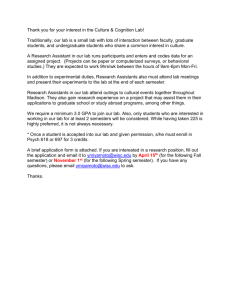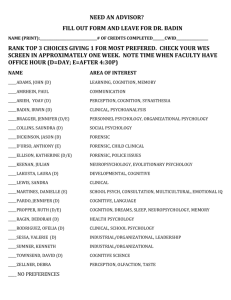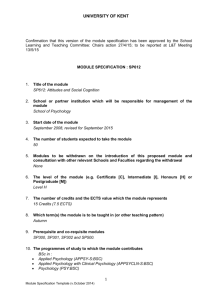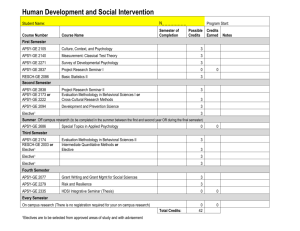Proposal
advertisement
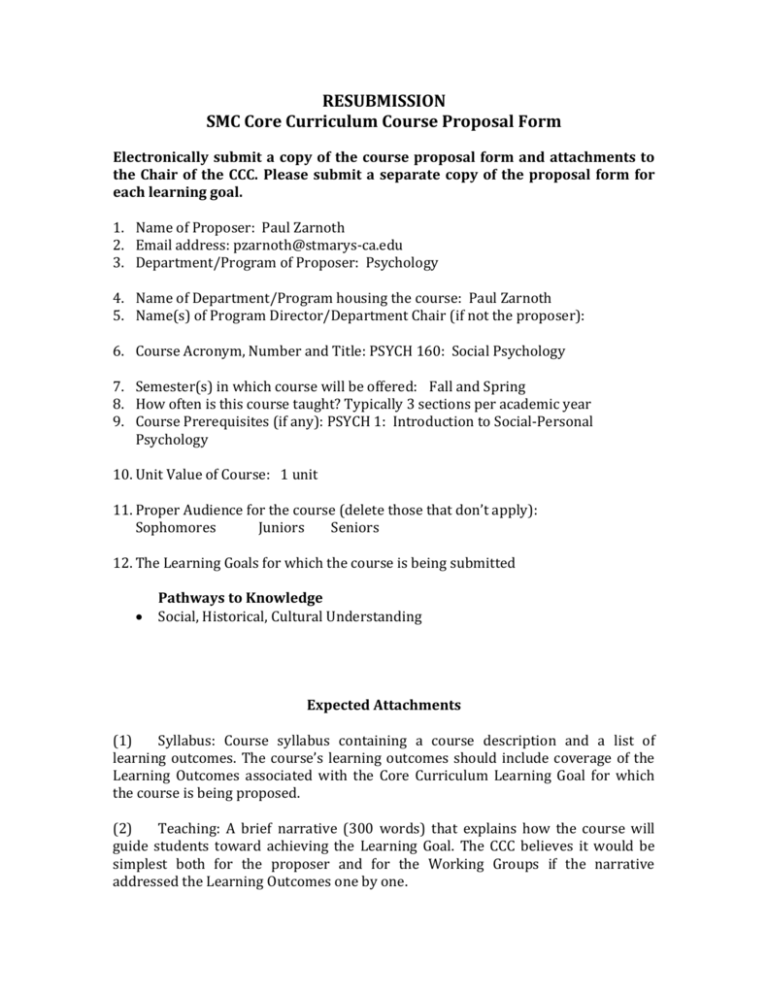
RESUBMISSION SMC Core Curriculum Course Proposal Form Electronically submit a copy of the course proposal form and attachments to the Chair of the CCC. Please submit a separate copy of the proposal form for each learning goal. 1. Name of Proposer: Paul Zarnoth 2. Email address: pzarnoth@stmarys-ca.edu 3. Department/Program of Proposer: Psychology 4. Name of Department/Program housing the course: Paul Zarnoth 5. Name(s) of Program Director/Department Chair (if not the proposer): 6. Course Acronym, Number and Title: PSYCH 160: Social Psychology 7. Semester(s) in which course will be offered: Fall and Spring 8. How often is this course taught? Typically 3 sections per academic year 9. Course Prerequisites (if any): PSYCH 1: Introduction to Social-Personal Psychology 10. Unit Value of Course: 1 unit 11. Proper Audience for the course (delete those that don’t apply): Sophomores Juniors Seniors 12. The Learning Goals for which the course is being submitted Pathways to Knowledge Social, Historical, Cultural Understanding Expected Attachments (1) Syllabus: Course syllabus containing a course description and a list of learning outcomes. The course’s learning outcomes should include coverage of the Learning Outcomes associated with the Core Curriculum Learning Goal for which the course is being proposed. (2) Teaching: A brief narrative (300 words) that explains how the course will guide students toward achieving the Learning Goal. The CCC believes it would be simplest both for the proposer and for the Working Groups if the narrative addressed the Learning Outcomes one by one. 1. Examines human activity in particular periods or places from a social, cultural or historical perspective. Social psychology is the study of human behavior and cognition from a social perspective. These social behaviors and social cognitions are studied within the context that they occur. For example, students can be expected to learn about social behavior as it takes place within the classroom (e.g., Kelley, 1950; Steele & Aronson, 1995; Aronson & Bridgeman, 1979), the workplace (e.g, Stansfeld et al., 1998; Heilman et al., 2004) and the courtroom (e.g., Eberhardt et al., 2006; Haney, 1984; Liptak, 2011). The research that we discuss was primarily conducted in Western cultures over the past century. Therefore, the findings are best generalized to those locations and within a relatively recent timeframe. On the other hand, research studies conducted in non-Western cultures is discussed in at least one-third of the class meetings (on a MWF schedule), so it certainly would not be accurate to characterize the focus as exclusively U.S. based. The role of history is not as heavily emphasized; however, it too has a place in the course. As one simple example, one day of class is dedicated to describing modern prejudice in the U.S. as an automatic, ambivalent, and ambiguous set of biases that differ fundamentally in process from the nature of prejudice a half century ago. As mentioned above, Social Psychology is the study of human behavior and cognition from a social perspective. Students learn how the social situation impacts human cognition and human behavior. I will illustrate what I mean by this by describing the several examples from the schedule of topics found within the syllabus. The title of the second day of class is “Social Psychology – A focus on the social situation.” Here, we introduce the surprising impact that other people have on us. For example, Eisenberger et al. (2003) used fMRI scans to find that individuals respond neurologically to ostracism in much the same way that they respond to physical pain. Coan et al. (2006) found that individuals’ neurological stress reactions were reduced when they held someone’s hand, especially when the person was one’s spouse, and especially when the individual was more satisfied with her relationship with her spouse. Following a discussion of research methodology, the first major topic in the course is attribution, defined as the process of making sense of the actions of others. Here, we begin to discuss in depth how people respond to the social situation. Most notably, we talk about the fundamental attribution error, the tendency for people to exaggerate the importance of personality and to underestimate the role of the social situation in determining the behaviors of others. This bias has many important consequences, for example it helps to explain why many jurors in rape trials end up blaming the victim (e.g., Bell et al., 1994). The next major topic is attitudes -- our evaluative responses to people, objects, and ideas. We discuss how attitudes are impacted by other people and the media (i.e, persuasion), and we discuss how attitudes combine with perceived social norms to direct human behavior. Over the next several weeks, we discuss positive attitudes (e.g., interpersonal attraction), positive behaviors, (e.g., helping), negative behaviors (e.g., violence) and negative attitudes (e.g., prejudice). Students learn about the impact of the social situation on each of these. For example, we discuss how the presence of other people reduces the likelihood that one person will aid someone in need due to pluralistic ignorance and the diffusion of responsibility. We discuss the impact of violent media and pornography on human aggression. We discuss the impact of prejudice within a society on members of stigmatized groups (e.g., stereotype threat and attributional ambiguity). The next major topic is group behavior. Students learn about how deindividuation can occur within a group context, as well as how the group context impacts human performance and decision making. Finally, we end the semester with the topics of conformity, compliance and obedience, three additional ways in which human behavior is impacted by the social situation. 2. Presents theories of human behavior, relations, culture, or institutions; or interpretations of historical causation and change. Social psychology is the scientific study of human social behavior and cognition. The course is largely a survey of prominent theories of social behavior including the theory of causal attribution, social identity theory, the theory of cognitive dissonance, the general aggression model, the elaboration likelihood model, the theory of social facilitation, etc. If asked, I could present a much longer list of theories of social behavior discussed in the course. I could also present brief descriptions of each. I trust that this will not be necessary. 3a. Asks students to employ social science or historical methodology to collect evidence about the social world. AND 3b. Asks students to employ social science or historical methodology to interpret evidence about the social world. As stated earlier, social psychology is the scientific study of human social behavior and cognition. Therefore, students in the course are expected to understand and employ the methodology of the field. Early in the semester (typically beginning the first week of the semester), the students receive an overview of different methodologies commonly used by social psychologists. They also learn about a few special problems related to the methodology of social psychology including the use of deception, the use of non-representative samples, the use of laboratory exercises lacking in mundane realism, the difficulty of interpreting correlational findings, etc. For the remainder of the semester, students are presented with a survey of social psychological theories and the research that has been employed to develop and test these theories. Multiple research studies are discussed in a typical hour-long class session. In addition, students are also asked to read and analyze a series of professional research articles. Furthermore, students also learn how to design a research study and to interpret the meaning of the evidence. (See the Learning section for more detail.) (3) Learning: A brief explanation of how coursework (e.g., papers, exams, videotaped presentations) will be used to measure student achievement of each of the Learning Outcomes. Please address the outcomes directly and one by one. 1. Examines human activity in particular periods or places from a social, cultural or historical perspective. AND 2. Presents theories of human behavior, relations, culture, or institutions; or interpretations of historical causation and change. The exact methods used to measure student achievement of these two learning outcomes differ somewhat from one instructor to the next. Exams, papers, and quizzes are the most common methods. Three or four exams are administered in every section of the course. One instructor uses an essay format. More than a week before each exam, students are given a list of approximately two dozen essay questions, approximately six of which then appear on the exam. Another instructor uses a mixed-format exam, which includes both multiple choice questions and a set of short-answer questions requiring responses that are each about one to two paragraphs in length. In all cases, students are tested on their understanding of social psychological theories regarding a variety of human social behaviors. A few sample short-answer questions are included below to illustrate the way in which student achievement of these two learning outcomes is assessed. 1. According to Kelley’s model of causal attribution, what three pieces of information do people look for in order to decide whether to make an internal or external attribution about another person’s behavior? (Provide both the relevant terms and their definitions.) To illustrate your understanding of these concepts, describe three commercials or advertisements, each of which supplies one of the three kinds of information. 2. Our behavior does not always reflect our attitudes. How does Ajzen and Fishbein’s theory of planned behavior explain this phenomenon? 3. Kiesler and Baral (1970) wrote an article entitled, “The search for a romantic partner: The effects of self-esteem and physical attractiveness on behavior.” What was the main finding of their research? Use social exchange theory to explain this finding. Then use cognitive dissonance theory to explain the finding. 4. Describe the results of the research conducted by Bushman (2002) and explain how the participants’ violent behavior could be explained by the general aggression model. 3a. Asks students to employ social science or historical methodology to collect evidence about the social world. The collection of evidence about human social behavior occurs nearly every day in this class through a series of in-class experiments. Occasionally, students collect data outside of class as well. For example, in one class, students are presented with two theories of first impressions (the cognitive schema model and the central trait theory). Students work together to develop an experiment to test the competing hypotheses of these two theories. Students then each gather data from a few friends before the next class, at which time the data is put together and interpreted by the class. On another occasion, students test the impact of expertise on conformity by asking by asking seniors and first-year students how much money they spend per semester on textbooks. The students in the class first add either high or low estimates to the response form before asking volunteers outside of class to supply their own answers. Typically, the seniors who participate are not as influenced by the earlier responses to the same degree as are the first-year students. These data collection exercises, and others like them, are useful experiences for the students; however, simple data collection doesn’t require deep understanding of research methodology. Therefore, the completion of these exercises is only graded as part of the students’ participation grades. Students are able to demonstrate more thorough understanding of social science methodology when they write research proposals for the class. Students read a series of research articles throughout the semester, and individual students select four papers to think about more deeply. The students write “thought papers” in response to each of these articles. Two of these thought papers take the form of research proposals. Students are asked to report a hypothesis that builds upon the research they read, to explain the rationale for their hypothesis, and to provide a detailed description of the methodology that they would use to test their hypothesis. 3b. Asks students to employ social science or historical methodology to interpret evidence about the social world. The students’ ability to interpret research evidence is evaluated in a variety of ways. First, students demonstrate their ability to interpret research evidence during class discussions of the assigned research articles. Second, the learning outcome is assessed through the four thought papers that the students write. In each of the thought papers, the students briefly summarize the research methods and the results. Students are expected to interpret the research findings with an awareness of the strengths and limitations of the research methodologies employed. They then describe ways that the research topic and results relate to other theories and concepts discussed in the course. Finally, the students propose a research study for two of their four papers (as described in 3b above) and describe an application of the findings for their other two papers. These application papers require that students think deeply about the meaning of the evidence and the way in which the findings could be used to benefit either an individual or a community. Finally, students’ understanding of research methodology is evaluated though exams using questions like the ones below: 1. Kelley (1950) conducted an experiment on impression formation. Identify the independent variable and one dependent variable in this study. Briefly describe a change in the experimental design that would cause a confound to exist. 2. Which two competing desiderata for research are most problematic for laboratory experiments? Give an example of a laboratory experiment discussed in class and briefly explain how it may fail to meet these two desiderata. Any course approved for the core must provide data for the assessment of Core curriculum learning goals at an institutional level. Via this proposal a chair/program director agrees to oversee the submission of the student work necessary for the assessment of the learning goals. If the proposal is from an instructor, that individual agrees to oversee submission of work from appropriate sections of their course. Similarly, while courses, and individual sections within courses, may vary, the Core should provide somewhat consistent experiences within each Learning Goal. To this end, by submitting this proposal a chair/program director/instructor agrees that instructors of Core courses will participate in assessment exercises.
